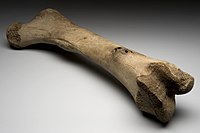
Photo from wikipedia
BACKGROUND Pseudomeningoceles are a rare cause of bone erosions. Development of such erosions in the C2 vertebral body and the odontoid process can lead to life-threatening instability. Treatment options to… Click to show full abstract
BACKGROUND Pseudomeningoceles are a rare cause of bone erosions. Development of such erosions in the C2 vertebral body and the odontoid process can lead to life-threatening instability. Treatment options to regain stability include atlantoaxial and occipitocervical fusion. For patients with a history of Chiari decompression and large C2 lesions, common fusion techniques are not always feasible. In addition, fusion surgery sacrifices physiologic motion and is therefore a disabling procedure, especially for young and active patients. CASE DESCRIPTION We report a novel combined open operative and subsequent minimal invasive filling technique of several instable osteolytic/cystic areas within the C2 vertebra of a 28-year-old woman. The underlying cause for the lesions was a pseudomeningocele communicating with the vertebral body. This was an incidental finding 15 years after foramen magnum decompression with C1 and partial C2 laminectomy for Chiari malformation. Novel treatment included open posterior surgery with total laminectomy of the remaining C2 arch and refilling the odontoid with viscous beta tricalcium phosphate and polymethylmethacrylate bone cement. Postoperative 6- and 12-month follow-up computed tomography imaging showed a stable incorporation of the filling. CONCLUSIONS Life-threatening fractures at the occipitocervical junction are rare and often are due to high-impact trauma. Osteolytic changes at those bone compartments are a potential cause for pathologic fractures during normal daily activities. In this case, increased pressure on the bone due to a pseudomeningocele resulted in slow bone loss without symptoms. A novel combined technique of bone filling was applied successfully to stabilize the C2 vertebral bone.
Journal Title: World neurosurgery
Year Published: 2017
Link to full text (if available)
Share on Social Media: Sign Up to like & get
recommendations!